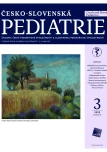Suicidality and self-harming in childhood and adolescence – actual situation
Authors:
Koutek Jiří; Kocourková Jana
Authors‘ workplace:
Dětská psychiatrická klinika 2. lékařské fakulty a Fakultní nemocnice v Motole, Praha
Published in:
Čes-slov Pediat 2022; 77 (3): 131-136.
Category:
Comprehensive Report
Overview
The authors deal with autoaggressive behavior in children and adolescents, suicidal behavior in the form of suicide attempt and completed suicide, and self-harm. Especially recently, this psychopathological behavior has intertwined and potentiated each other. There has also been an increase in self-harm and suicidal behavior in connection with the burden of the covid pandemic.
Keywords:
Adolescents – children – suicidal behavior – self-harm – covid pandemic
Sources
1. P elkonen M, Marttunen M. Child and adolescent suicide: epidemiology, risk factors, and approaches to prevention. Paediatr Drugs 2003; 5(4): 243–65.
2. S obotková V, Blatný M, Jelínek M, et al. Typologie antisociálního chování v rané adolescenci a jeho vztah k dalším formám rizikového chování. Čsl psychologie 2009; LIII(5): 428–440.
3. C ash SJ, Bridge JA. Epidemiology of suicide and suicidal behavior. Curr Opin Pediatr 2009; 21(5): 613–619.
4. Brent DA, et al. The treatment of adolescent suicide attempters study (TASA ): Predictors of suicidal events in an open treatment trial. J Am Acad Child Adolesc Psychiatry 2009; 48(10): 987–996.
5. Cleaver K. Characteristics and trends of self-harming behavior in young people. Br J Nurs 2007; 16(3): 148–152.
6. C hylová M, Pálová E, Kovaničová M, et al. Prieskum suicidálního správania v období dospievania. Čsl psychologie 2011; 55 : 306–315.
7. Junuzovic M, Toporska Lind KM, Jakobsson U. Child suicides in Sweden, 2000–2018. Eur J Pediatrics 2022; 181 : 599–607.
8. P feffer CR, Jiang H, Kakuma T. Child-Adolescent Suicidal Potential Index (CASPI): a screen for risk for early onset suicidal behavior. Psychol Assessment 2000; 12(3): 304–318.
9. C asillas A, Clark LA. Dependency, impulsivity, and self-harm: traits hypothesized to underlie the association between cluster B personality and substance use disorders. J Personal Disord 2002; 16(5): 424–436.
10. N elson G, Hanna R, Houri A, et al. Protective Functions of religious traditions for suicide risk. Suicidology Online 2012; 3 : 59–71.
11. M ezinárodní klasifikace nemocí, 10. revize. Praha: Psychiatrické centrum 1992.
12. DSM –5, Diagnostický a statistický manuál duševních poruch. Praha : Hogrefe-Testcentrum 2015
13. Jacobson CM, Gould M. The epidemiology and phenomenology of non-suicidal self-injurious behavior among adolescents: a critical review of the literature. Arch Suicide Res 2007; 11(2): 129–147.
14. S kegg K. Self-harm. Lancet 2005; 366 : 1471–1483.
15. N ixon MK, Cloutier PF, Aggarwal S. Affect regulation and addictive aspects of repetitive self-injury in hospitalized adolescents. J Am Acad Child Adolescent Psychiatry 2002; 41(11): 1333 – 1341.
16. Y oung R, Sweeting H, West P. Prevalence of deliberate self harm and attempted suicide within contemporary Goth youth subculture: longitudinal cohort study. BMJ 2006; 332 : 1058–1061.
17. Whitlock JL, Powers JL, Eckenrode J. The virtual cutting edge: the internet and adolescent self-injury. Dev Psychol 2006; 42(3): 407 – 417.
18. F avaro A, Ferrara S, Santonastaso P. Self-injurious behavior in a community sample of young women : relationship with childhood abuse and other types of self-damaging behaviors. J Clin Psychiatry 2007; 68(1): 122–131.
19. C royle KL, Waltz J. Subclinical self-harm: range of behaviors, extent, and associated characteristics. Am J Ortopsychiatry 2007; 77(2): 332–342.
20. S ingh S, Roy D, et al. Impact of COVID-19 and lockdown on mental health of children and adolescents: A narrativ review with recommendations. Psychiatry Res. 2020; 293 : 113429.
21. Vuillier L, May L, et al. The impact of the COVID-19 pandemic on individuals with rating disorders: the role of emotion regulation and exploration of online treatment experiences. J Eating Disorders 2021; 9 : 10.
22. Winkler P, et al. Increase in prevalence of current mental disorders in the kontext of COVID-19: analysis of repeated nationwide cross - -sectional surveys. Epidemiol Psychiatr Sci 2020; 1–8.
23. T aquet M, et al. Bidirectional associations between COVID-19 and psychiatric disorder: retrospective kohort studie of 62 354 COVID-19 cases in the USA. [online]. Lancet Psychiatry 2020. doi: 10.1016/ S2215-0366(20)30462-4.
Labels
Neonatology Paediatrics General practitioner for children and adolescentsArticle was published in
Czech-Slovak Pediatrics

2022 Issue 3
- What Effect Can Be Expected from Limosilactobacillus reuteri in Mucositis and Peri-Implantitis?
- The Importance of Limosilactobacillus reuteri in Administration to Diabetics with Gingivitis
Most read in this issue
- Autism spectrum disorders
- Gender incongruence in childhood
- Suicidality and self-harming in childhood and adolescence – actual situation
- Refeeding syndrome
